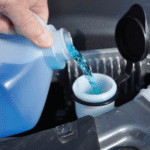
Common Ford Puma Problems and How to Fix Them

The Ford Puma is a stylish and efficient compact SUV that offers a solid blend of performance, technology, and comfort. However, like any vehicle, it isn’t immune to certain mechanical or electronic issues. Below, we detail the most common Ford Puma problems, their symptoms, and practical solutions to keep your car in top condition.
- 1. Ford Puma Automatic Transmission Problems
- 2. Fuel Injection System Faults
- 3. Premature Brake Wear
- 4. Electrical System Malfunctions
- 5. Air Conditioning and Climate Control Problems
- 6. Ford Puma Hybrid Battery Issues (For EcoBoost Hybrid Models)
- 7. Infotainment System Freezes or Malfunctions
- 8. Suspension and Noise Issues
- Preventive Maintenance Tips
- Conclusion
1. Ford Puma Automatic Transmission Problems
Symptoms
- Jerking or hesitation when shifting gears
- Delayed acceleration or rough gear changes
- Transmission warning light appearing on the dashboard
Causes
- Outdated transmission control module (TCM) software
- Low or contaminated transmission fluid
- Wear or damage to solenoids or clutch packs
Solutions
- Update the transmission software at an authorized Ford service center.
- Replace or flush the transmission fluid (recommended every 60,000–80,000 km).
- Inspect solenoids and mechanical components, repairing or replacing as necessary.
Tip: Avoid aggressive acceleration in stop-and-go traffic—this significantly reduces stress on the gearbox.
2. Fuel Injection System Faults
Symptoms
- Engine misfires or reduced power output
- Difficulty starting or poor idle
- Noticeable fuel odor or increased consumption
Causes
- Clogged or defective injectors
- Contaminated fuel or carbon buildup
- Faulty fuel pump or pressure regulator
Solutions
- Clean the injectors using a professional fuel system cleaner.
- Replace faulty injectors if cleaning doesn’t solve the issue.
- Use high-quality fuel and periodic additives to prevent carbon accumulation.
Maintenance Tip: Adding injector cleaner every 5,000–10,000 km can extend injector life and improve fuel economy.
3. Premature Brake Wear
Symptoms
- Grinding or squeaking noises when braking
- Reduced braking performance
- Vibrations felt through the brake pedal
Causes
- Use of low-quality brake pads
- Excessive stop-and-go city driving
- Worn brake discs or calipers
Solutions
- Install premium brake pads and discs from trusted manufacturers.
- Inspect the braking system regularly—ideally every 10,000–15,000 km.
- Avoid harsh or sudden braking whenever possible to extend pad lifespan.
Expert Insight: The Ford Puma’s regenerative braking system (in mild-hybrid variants) can sometimes cause uneven pad wear if not properly calibrated—get this checked during routine service.
You may be interested in reading Ford Puma Automatic Transmission Problems: Common Issues, Causes, and Fixes
Ford Puma Automatic Transmission Problems: Common Issues, Causes, and Fixes4. Electrical System Malfunctions
Symptoms
- Flickering dashboard lights or malfunctioning sensors
- Faulty headlight or taillight operation
- Sudden battery drain or random warning lights
Causes
- Corroded wiring harness connections
- Weak battery or alternator output
- Faulty fuses, relays, or grounding points
Solutions
- Inspect and clean corroded connectors using contact cleaner.
- Check all fuses and relays, replacing any damaged ones.
- Test the alternator and battery voltage, replacing components as needed.
- Perform a software update if electrical glitches persist.
Pro Tip: Moisture buildup near the headlight housing and fuse box is a known culprit—ensure proper sealing to prevent future issues.
5. Air Conditioning and Climate Control Problems
Symptoms
- Weak or inconsistent airflow
- Warm air blowing when cooling is on
- Clicking or rattling noises when the A/C is activated
Causes
- Low refrigerant (A/C gas) level
- Faulty compressor or condenser fan
- Clogged cabin air filter
Solutions
- Recharge the refrigerant gas to the correct level.
- Inspect and replace the A/C compressor or fan if malfunctioning.
- Clean or replace the cabin air filter every 15,000 km.
Preventive Step: Run the A/C system at least once a week—even during winter—to keep seals lubricated and the system functioning efficiently.
6. Ford Puma Hybrid Battery Issues (For EcoBoost Hybrid Models)
Symptoms
- “Hybrid system fault” message on display
- Loss of regenerative braking efficiency
- Battery not charging properly during driving
Causes
- Battery management software errors
- Degraded lithium-ion cells
- Faulty alternator or DC/DC converter
Solutions
- Update the hybrid system software at a certified Ford workshop.
- Perform a hybrid battery health check during scheduled maintenance.
- Replace the auxiliary 12V battery if the vehicle fails to start or exhibits electrical glitches.
Warning: Never attempt to service the hybrid battery yourself—it operates at high voltage and requires trained technicians.
7. Infotainment System Freezes or Malfunctions
Symptoms
- Touchscreen lag or unresponsive Sync system
- Bluetooth or CarPlay connection failures
- Navigation system freezing mid-drive
Solutions
- Reset the Sync system through the settings menu.
- Install the latest Ford Sync software update.
- Disconnect and reconnect your phone, ensuring firmware is up-to-date.
Quick Fix: A soft reset (holding the volume and skip buttons together for 10 seconds) often resolves most Ford Sync malfunctions.
You may be interested in reading Ford Puma Automatic Transmission Problems: Common Issues, Causes, and Fixes
Ford Puma Automatic Transmission Problems: Common Issues, Causes, and Fixes Ford Puma Windshield Washer Not Working — Complete Fix Guide
Ford Puma Windshield Washer Not Working — Complete Fix Guide8. Suspension and Noise Issues
Symptoms
- Clunking noise when turning or going over bumps
- Uneven tire wear or pulling to one side
- Excessive vibration at higher speeds
Causes
- Worn-out shock absorbers or bushings
- Misaligned wheels or unbalanced tires
- Faulty anti-roll bar links
Solutions
- Replace worn suspension components (struts, mounts, bushings).
- Balance and align the wheels regularly.
- Inspect tires for uneven wear or sidewall damage.
Maintenance Tip: Check suspension alignment every 20,000 km to ensure safe and comfortable handling.
Preventive Maintenance Tips
To avoid the most common Ford Puma issues:
- Change engine oil and filters as per the manufacturer’s schedule.
- Perform a full system diagnostic twice a year.
- Keep your battery terminals clean and sealed.
- Use only OEM or high-quality aftermarket parts.
Optional: A car leasing or renting plan can also cover maintenance costs, ensuring peace of mind without unexpected repair expenses.
Conclusion
The Ford Puma remains one of the most reliable small SUVs in its class, but awareness of its potential issues ensures longevity and smooth performance. With regular maintenance, prompt repairs, and software updates, you can keep your Ford Puma performing flawlessly for years.
You may be interested in reading Ford Puma Automatic Transmission Problems: Common Issues, Causes, and Fixes
Ford Puma Automatic Transmission Problems: Common Issues, Causes, and Fixes Ford Puma Windshield Washer Not Working — Complete Fix Guide
Ford Puma Windshield Washer Not Working — Complete Fix Guide Ford Puma Alternator Problems: Diagnosis, Symptoms, and Fixes
Ford Puma Alternator Problems: Diagnosis, Symptoms, and FixesIf you want to know other articles similar to Common Ford Puma Problems and How to Fix Them you can visit the category Common Problems.
Deja una respuesta






More content of your interest